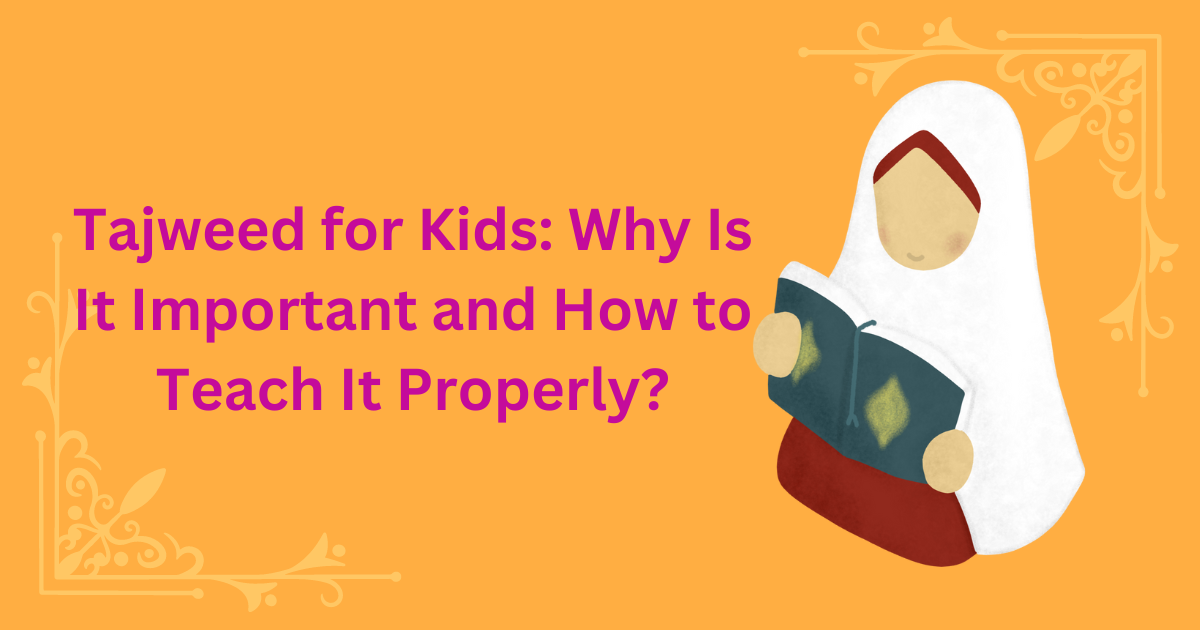Teaching Tajweed to kids ensures their Quranic recitation is both correct and beautiful, fulfilling a key Islamic duty. Simplifying complex rules like pronunciation, articulation, and recitation techniques, Tajweed for kids preserves the meaning and beauty of the Quran while building character. Engaging methods like storytelling, interactive games, and consistent practice in a supportive environment make learning Tajweed both fun and effective. Start early, make it enjoyable, and create a lifelong connection to the divine words of the Quran.
Imagine listening to your kid’s sweet voice when he is reciting the Quran correctly and beautifully! With Tajweed for kids, this dream will come true.
How it’s amazing for him to be motivated and ambitious to hear “Recite and ascend (in ranks) as you used to recite when you were in the world. Your rank will be at the last Ayah you recite”[Abu Dawud and At- Tirmidhi].
يقال لصاحب القرآن اقرأ وارتق ورتل كما كنت ترتل في الدنيا، فإن منزلتك عند آخر آية تقرؤها”. (رواه أبو داود والترمذي)”
It is a true promise of the Prophet (PBUH) to whoever memorises the Quran, recites it, and masters its recitation.
The journey to this dream will start from here, So let’s embark on this blessed mission together!
Table of Contents
What is Tajweed?
Linguistically, Tajweed means improvement and perfection. It is an infinitive in Arabic derived from the verb “jawwad” which means to beautify and improve.
And technically, Tajweed is the science of how to pronounce the words of the Holy Quran, in terms of pronouncing each letter from its point of articulation and giving it its due without difficulty by applying the various rules of recitation. This happened as people received it through the chain of oral transmission connected to the Messenger of Allah (PBUH).
What Is Tajweed for kids?
Tajweed for kids is breaking down the fundamental rules of Tajweed into simple, easy-to-understand concepts tailored specifically for kids.
We can explain Tajweed to kids by comparing it to learning to pronounce words correctly in any language, making the Quran sound beautiful and clear when recited.
Why Is Tajweed for Kids Important?
It was mentioned in the noble hadith that the Prophet (PBUH) said: “Whoever would like to recite the Quran as fresh as when it was revealed, let him recite it like Ibn Umm ‘Abd.” who’s Abdullah bin Masud.
Reference: Sunan Ibn Majah 138.قد رُوي عن النبي صلى الله عليه وسلم، أنه قال: “من أراد أن يقرأ القرآن غضا، فليقرأه بقراءة ابن أم عبد” ـ يعني ابن مسعود.
This hadith encourages learning from experts to ensure correct recitation of the Quran, which reflects that learning Tajweed is definitively crucial for several reasons:
1- Individual Obligation:
Every Muslim is obligated to recite the Quran correctly.
As the Almighty says: “And recite the Quran with measured recitation.” [Al-Muzzammil: 4]
وَرَتِّلِ الْقُرْآنَ تَرْتِيلًا” (المزمل 4)”
2- Preventing Mistakes:
Applying Tajweed rules and practising regularly helps preserve the tongue from linguistic mistakes, which will improve your kid’s linguistic skills.
3- Preserving Beauty and Meaning of Verses:
Proper pronunciation and intonation help maintain the Quran’s beauty and ensure accurate understanding of its verses.
4- Spiritual Worship:
Reciting the Quran correctly is a way to worship Allah. This motivation encourages children to be patient and proud of their efforts.
5- Character Building:
Mastering Tajweed teaches patience and perseverance, rewarding children with a sense of divine reward.
6- Role Models:
Having a skilled and understanding teacher with your child is important for him to find a good role model to follow.
Basic Tajweed rules And Examples For kids:
Here we present the Tajweed basics that every Muslim child can learn to recite the Quran more accurately.
1- The Arabic letters:
The first step of the child towards a perfect application of Tajweed is to know the Arabic letters, their sounds, shapes, and diacritics and punctuation marks. This will enable him to read the word and the verse accordingly.
2- Makharij Al-Huruf (Articulation points):
Makharij Al-Huruf are the rules that clear the correct pronunciation of each letter and knowing how to pronounce them from the vocal tracts which are the throat, the tongue, the lips, the upper part of nose, the empty space between mouth and throat.
3- The rules of the silent Noon (Noon Sakinah) and Tanween:
It is important to teach your kid how to pronounce the Noon Sakinah or Tanween if it comes without Harakat, and that the method differs according to the letters that follow it.
The pronunciation rules for a specific Arabic letter depend on the letter that follows it. If followed by throat letters (Hamza, Haa, Ayn, Haa, Ghain, Khaa), it is pronounced clearly, which is called Idhar. When followed by Yaa, Raa, Meem, Lam, Waaw, or Noon, it merges into the following letter, known as Idgham.
If followed by Baa, it transforms into Meem in pronunciation, a rule called Iqlab. For any other letter, it is pronounced in a manner between clear and merged, referred to as Ikhfaa.
4) The rules of (Meem sakinah):
The letter “meem” is a labial letter that is produced by closing the lips. So all of the rules related to the Meem Sakinah are called “Shafwi” in Arabic which means labial.
If you find a (Meem Sakina) in Mushaf there are only 3 ways to pronounce it:
1- Hiding the silent meem with nasalization if it comes before the “Baa” letter, It’s called “Ikhfaa Shafawi”
2- Inserting a silent meem with a “Meem” after it with a full nasal sound It’s called “Idgham Shafawi”
3- Pronouncing the letter “Meem” clearly with “all letters” except “meem and Baa”is called “Izhar Shafawi”.
5) Mudood Rules (Prolongation):
Once the child learns the three long vowels (Madd Letter) which are (Alif, Waaw, and Yaa), He will be able to understand the details that accompany these letters, such as length and times that must be taken into consideration when reading in different places in the Quran.
6) Sifat Al-Huruf (Characteristics of Letters):
Sifat Al-Huruf contains the way letters are pronounced that distinguishes each letter from others. Such as (Al-Jahr, Al-Hams, Al-Qalqalah,…etc).
Fun ways to learn Tajweed for Kids:
As an adult guardian, you need to come up with fun ways to learn Tajweed for kids, and here we must stress on the idea of having fun; having fun with your kids will strengthen your relationship and you can guarantee the way to your child’s mind if you capture his love!
Therefore, teaching children in general requires that the teacher has a high level of understanding of the child’s psychology and the way to deal with him gently and realising the difference in comprehension from one child to another.
Therefore, some of the fun ways recommended to use in teaching Tajweed to kids include:
1- The narrative way:
Stories generally attract adults and children, so when we link a principle of Tajweed to a story, or link the application of Tajweed to a specific story, this will make it easier for the child to recall information.
2- The emotional way:
Bringing joy to the child and accepting the child’s mistakes and dealing with them positively will make the Quran teacher one of the most beloved persons to them, and this has a great impact on their personality and their desire to recite the Quran with enthusiasm.
3- The fun way:
Fun is one of the most important entrances to the hearts of children, and it may even be the most important of all!
Therefore, using some cartoon clips and interactive games will attract the child to learn Tajweed and to be eager to do it with patience to improve his performance.
How to Recite the Quran with Tajweed for kids?
Adhering to a systemized plan will help your kid to recite the Quran with Tajweed rules successfully:
1- Start now:
No matter how old your child is, starting with him now is better than postponing it for later.
2- Learn the Arabic letters and how to pronounce it:
Start by teaching your child the Arabic letters, how to pronounce them, and how to form a word and a sentence. If you are not an expert in teaching Arabic, You can ask for help from an expert.
3- Daily reciting the Quran:
The more your child practises Tajweed, the better his recitation will be. You can do this yourself or by choosing a teacher who is skilled in dealing with children in particular, and has experience in teaching the Quran to non-Arabic speakers.
4- Choose the time and place that is appropriate for your child’s comfort:
Your child’s comfort helps him increase his focus, so make sure to teach him in a comfortable environment and at an appropriate time.
5- Use different channels to teach Tajweed
Try every path that can make a progress in your child’s Tajweed Level, Such as:
- Listening to the Quran while trying to recite it.
- Repeating the verse you want your kid to memorise as much as you can.
- Use mobile applications that allow the re-correction of your kid’s recitation.
- Let your kid recall the verses without looking at the Mushaf.
Learn Tajweed Online With Bayan al-Quran:
Embark on a transformative journey of Quranic learning with Bayan Al-Quran’s state-of-the-art Tajweed courses. Our online platform is dedicated to providing an authentic and immersive Tajweed learning experience, bringing the timeless beauty of Quranic recitation to learners around the world.
Bayan al-Quran offers the opportunity to earn an Ijazah in Tajweed, providing a recognized certificate for mastering Quranic recitation. Join our program to receive expert guidance, learn with qualified instructors, and enhance your skills in Tajweed.
Embark on a transformative journey to master Tajweed with Bayan al-Quran. Our comprehensive program is designed to elevate your understanding and application of Tajweed rules, ensuring a profound connection with the Quran.
🎓 Expert Guidance:
Benefit from expert instructors well-versed in the nuances of Tajweed. Our carefully crafted lessons break down complex rules into digestible segments, catering to learners of all levels.
✨ Key Features:
- Learn Tajweed in a structured, step-by-step manner.
- Access high-quality instructional materials.
- Practice with real-time feedback from experienced tutors.
- Convenient, flexible learning schedules to suit your pace.
- Immerse yourself in the melodious tones of Quranic recitation.
🌟 Why Choose Bayan al-Quran?
At Bayan al-Quran, we prioritize your journey to Tajweed proficiency. Join our vibrant community of learners committed to perfecting their Quranic recitation. Enrich your spiritual experience and build a lifelong connection with the divine words of the Quran.
The Conclusion:
Tajweed is the science of pronouncing the Quran correctly. For kids, Tajweed simplifies these rules to make the Quran sound clear and beautiful. It ensures correct recitation, prevents mistakes, preserves meaning, and builds character.
Key rules include learning Arabic letters, articulation points, and specific rules for silent Noon, Tanween, and Meem Sakina. Fun methods like stories and interactive games make learning engaging.
A structured plan with early start, daily recitation, and a comfortable environment helps effectively teach Tajweed to children.

















